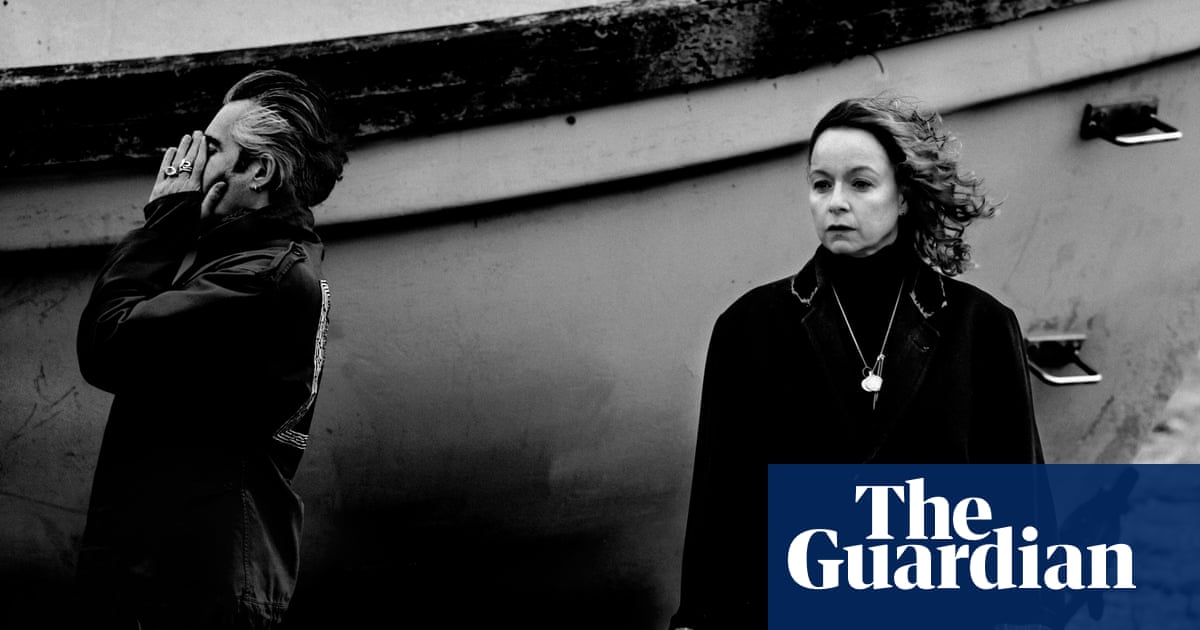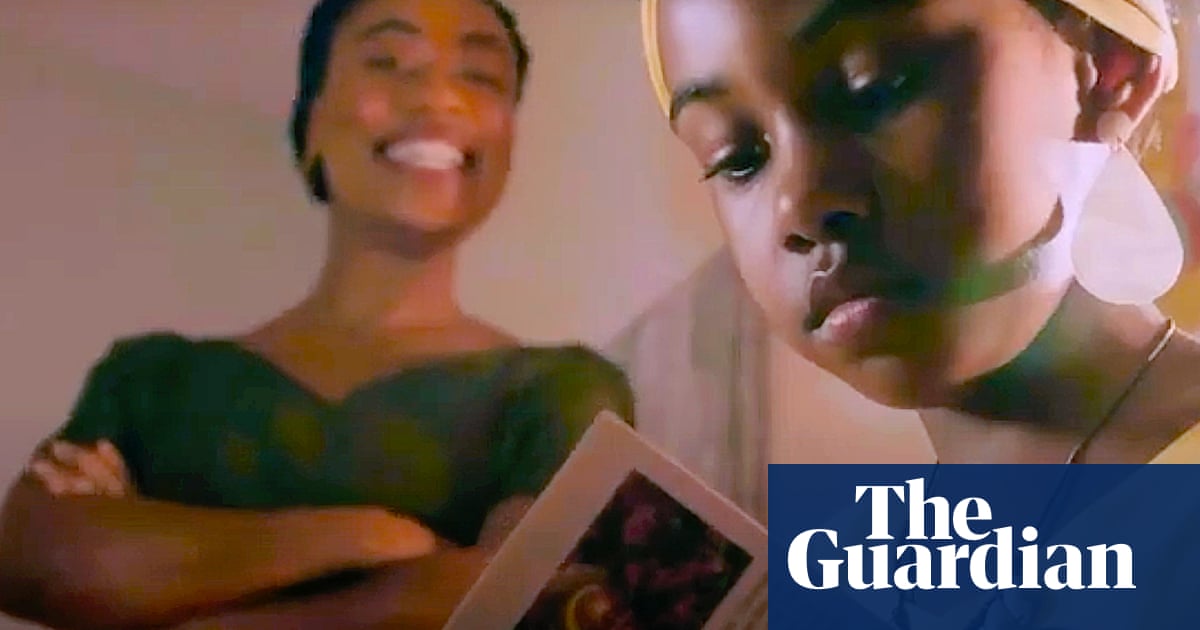
Gilla Band guitarist Al Duggan is unpicking the loose concept behind the Irish group’s third album, Most Normal. Their first, 2015’s Holding Hands With Jamie, ended with frontman Dara Kiely screaming. Their second, 2019’s The Talkies, “opened with him having a panic attack and ended with him breathing calmly”, he explains. “If there’s a linear progression happening through these records, this next record should feel like you’re wandering through a dreamscape.” But for all his talk of reading up on “dream cycles and circadian rhythms”, Most Normal’s vibe is closer to nightmare, its wilful rollercoaster of noise strafing listeners with distortion as Kiely pinballs between surrealist gabble and desperate, paint-stripping howls.
This turbulent masterpiece is the work of musicians committed to the creative possibilities within discomfiting sounds. They weren’t always this way: in their teens, three-quarters of Gilla Band were members of Dublin indie rockers Harrows. “We were really terrible,” says Duggan. “Arctic Monkeys had a real fucking chokehold over our generation.” Nevertheless, Duggan says there was “some interest from Sony Ireland. We thought we were gonna be massive.” He grins: “Thank God nothing happened.”
Instead, Duggan, Kiely (then the group’s drummer) and bassist Daniel Fox fell under the spell of no wave, the antagonistic post-punk scene of late-70s New York. “The most extreme version of punk,” Duggan says, as the band convene in the London offices of their label, Rough Trade. “Way more exciting, and also really danceable.” The trio became fervent proselytisers, so much so that Kiely got kicked out of a party for putting Dish It Out by no wavers the Contortions on the stereo. “I thought people might like it, but the guy got very annoyed,” he says innocently. “He took it off, and then started playing Use Somebody by Kings of Leon on his guitar.”
No wave was the primary inspiration for their new group, Girl Band. (They changed their name to Gilla Band in late 2021: “We just didn’t feel like it was on, for the four of us to be called Girl Band any more,” says Duggan.) Other influences included hard-edged techno, bloody-minded US noisers Pissed Jeans and, says Kiely, “pretty much every artist name-checked on LCD Soundsystem’s Losing My Edge”. Newcomer Adam Faulkner took the drum stool, Kiely became vocalist, and their first song, In My Head, climaxed with his blood-curdling screaming. They picked it as the A-side to their 2012 debut single to “divorce ourselves from what we were trying to do in Harrows”, says Kiely. “We were choosing the road less travelled.”
Girl Band’s early, chaotic gigs held their peers in thrall – fellow Dublin band Fontaines DC cite them as a formative inspiration – while a brace of highly collectible early singles (released on formats including a handmade plywood box containing a flexidisc that erodes every time it’s played) charted their evolution away from traditional song structures. By 2015, the group had signed to Rough Trade, released their exhilaratingly cacophonous debut album and found themselves on the precipice of unlikely crossover success. But as promotional duties wore on, Kiely’s mental health worsened, after an earlier psychotic episode that had kept him awake for eight days followed by a “massive comedown” and a period in hospital. Early in 2017, the group cancelled all their imminent tour dates and went on indefinite hiatus.
“I was burnt out, I wasn’t living correctly,” Kiely says now. That screaming closing track of Holding Hands With Jamie, The Witch Dr, “literally described what it had been like to have ‘an episode’. And as we kept playing it live, I became more and more anxious. I gave a lot of myself in those performances and I didn’t really sleep. I was being an idiot and not nice to be around, and I didn’t really like myself. I had to learn a lot, and it was very, very tough to get through.”
The hiatus was, Duggan adds, “a disappointment, for sure. But the future of the band seemed inconsequential compared to the situation at hand.” The bond between the quartet strengthened as Kiely worked on his recovery, and in 2019 they decamped to Ballintubbert House, an old country house in County Laois, to make The Talkies. Drawing unlikely inspiration from Marvin Gaye’s 1971 song-suite What’s Going On, many songs shared key tonal references, while Kiely’s lyrics eschewed the veiled autobiography of the debut for depersonalised, conceptual conceits such as abandoning pronouns or writing solely in palindromes as on Aibohphobia.
But after a handful of shows in support of The Talkies, Covid prematurely halted touring. “We had numerous lockdowns in Ireland,” says Duggan. “But then they said: ‘You can be in a bubble with three other people.’ We were like: ‘That’s enough for us!’” Investing in recording gear, the quartet ensconced themselves at their rehearsal space; new directions were explored, old working practices exorcised. Embracing post-production and the-studio-as-instrument, they employed loops and Logic, twisting their post-Sonic Youth din into jarring new shapes. Ideas again came from unexpected quarters: their heavy use of filters was influenced by Earl Sweatshirt’s Some Rap Songs, while country crooner Ray Price inspired the postmodern Capgras, where an overdubbed Kiely narrates the band’s hardcore thrash like a director’s commentary. “Our mindset was no longer just: ‘Let’s write a post-punk track.’” says Duggan. “It was about sculpting sounds, manipulating them.”
Duggan says they wanted to channel the elastic surreality of the dreamspace. “Reality gets distorted in a dream. An elephant might walk past you and say: ‘How are you?’ and you just accept it.” The album’s contorted punk noise gives that surrealism a visceral edge, although it’s most present in Kiely’s lyrics. His characteristic unsettling absurdist imagery and dark wordplay abound, with recurring motifs of decaying teeth, sea creatures and balding barbers. Eight Fivers’ theme of “shit clothes” and “bootcut jeans” bought at cut-price Dublin supermarket JC’s, meanwhile, taps into Kiely’s “getting slagged at school for wearing my brother’s hand-me-downs. It’s about taking pride in owning the ‘flaws’ people see in you.”
For all Most Normal’s potent surrealism, its most powerful moment is also its most direct. Abandoning much of the preceding studio trickery, the closer, Post Ryan, finds Kiely speaking plainly of his mental health problems, declaring himself “in-between breakdowns” but “just the same prick”, touching upon a period when he lived in a tent in his back garden “for attention”, and concluding: “I get inevitable depression when I do nothing.”
“It’s the most honest I’ve ever been,” says Kiely. “When I played it to the other guys, I had to leave the room, because it was so on the nose. But I wanted to be direct about it, to address it, to solidify where I am at this point. It wasn’t like” – he claps his hands – “‘Right lads, I’m going serious …’, but this new approach could lead to interesting things in the future.”
Kiely seems energised by Most Normal, and the new possibilities that lay within his grasp. “The last time I had an episode was six years ago,” he says. “It seems like a different lifetime now.” The dreams they had as Harrows, of being “massive”, are long gone; what sustains them now is the creativity itself.
“If it all ended tomorrow, I’d be like: ‘Well, that was fucking amazing!’” Kiely says. “We’re incredibly grateful for the paths it’s taken us down. I love impressing the lads, and them impressing me. It makes me want to do more. They’re wonderful people, and to have that relationship, and be able to do the creative thing on top, is brilliant.”












